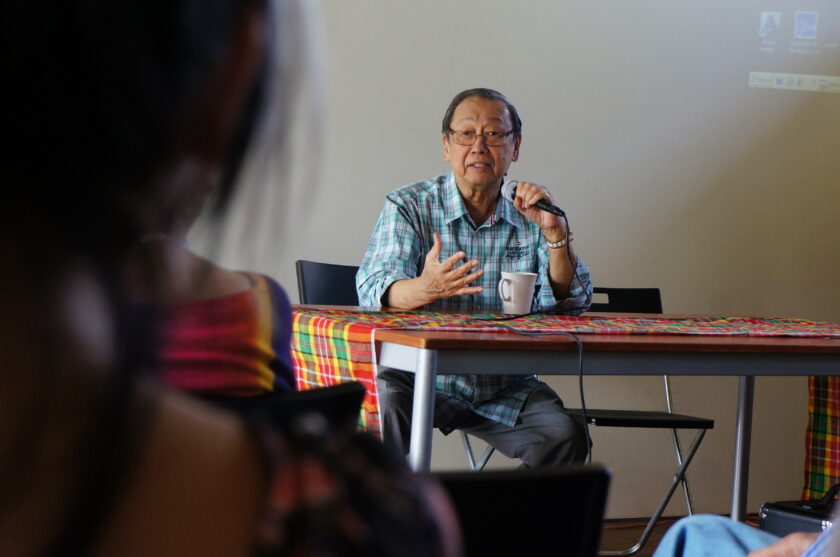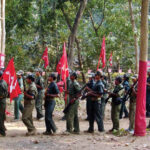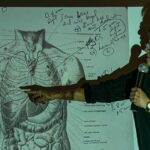![]() Book review of Jose Maria Sison’s On the Legal Democratic Mass Movement (Sison Reader Series Book 12)
Book review of Jose Maria Sison’s On the Legal Democratic Mass Movement (Sison Reader Series Book 12)
“The enemy is strong, yes. But we, too, are strong. If we unite—if those who have strength contribute strength, if those who have intellect contribute intellect…like the rain falling in torrents on a thousand raging rivers, we will sweep away all the filth of the ‘new society.’” – Alsang Bayan para sa Kalayaan at Demokrasya
Jose Maria Sison mentioned this in his narrative about the anti-Martial Law protest on September 30, 1977. Around 35,000 people bravely defied state goons in Manila to oppose the dictatorship.
Sison’s account of the massive protest is significant since it showed that the serious challenge to the notorious regime of Ferdinand Marcos emerged just a few years after the imposition of Martial Law. Indeed, there was an upsurge in protests after the assassination of opposition Senator Ninoy Aquino in 1983, but the resistance was already mobilizing tens of thousands in the streets during the first decade of the dictatorship.
It was a creative and militant demonstration of activism. Sison wrote about the street tactics used by the protesters to confuse authorities and evade the police dragnet. I was reminded of the 2019 protests in Hong Kong which gained global attention for embodying Bruce Lee’s ‘be like water’ philosophy. Sison’s description of the anti-Marcos protest also alluded to the power of the flowing water, but his example was “the rain falling in torrents on a thousand raging rivers”, which I think accurately captured the essence of Philippines’s national democratic movement from the countryside to the cities.
It remains a relevant formulation as it allows us to view our mass campaigns in the context of the continuing struggle for genuine social transformation.
Sison’s latest book contains numerous lessons about the urban mass movement, the history of student activism, the rise of the anti-dictatorship coalition, and the role of the Philippine mass movement in building a global anti-imperialist front.
For students of history, the book offers valuable and interesting information such as the success of activists in retrieving Marxist books and returning them to the UP Library system in the 1950s.
Sison also wrote about the big anti-fascist rallies in August and October of 1971 which mobilized up to 50,000 people. Again, this is an important account from a well-known anti-Marcos leader since the popular narrative is focused on the enduring legacy of the First Quarter Storm of 1970 and the Diliman Commune in 1971.
We need more testimonies and reports highlighting the lesser-known protests that contributed to the building of a formidable resistance to the dictatorship.
Sison’s teachings on the mass movement are based on his actual experience as a youth leader and political organizer. This book compiles his essential perspectives on strengthening the urban struggle. He emphasized that “mass actions are peaceful but militant, vigorous but nonviolent.” He repeated this point in 1995 when he wrote that “the urban-based democratic mass movement must be mainly legal and defensive in character even if verbally offensive, articulate and militant.”
He warned about the dangers of reformism which “reduces the people and their organizations to mere objects of periodic electioneering.” He further described it as “the systematic use of palliatives in order to preserve the fundamental interests of the exploiting classes.” He clarified in 2009 that “there is no error of reformism when there is no pontification that the struggle for reforms is the sole option of the people.”
He was in prison in 1985 when he gave this advice to fellow activists about the snap elections. “You may decide to extend direct support to the opposition presidential tandem which meet your criteria; or you may decide to extend only indirect support if you consider them undeserving of direct support.” He even encouraged the fielding of candidates. “You can join an electoral coalition not only because you directly or indirectly support the opposition presidential tandem, but also because you are interested in getting progressive candidates nominated and elected.” His message clearly didn’t advocate the boycotting of the historic elections contrary to what his detractors have been spreading to malign his political legacy.
The second part of the book reflects his virtual interactions with people’s organizations in his respected role as a veteran Filipino activist and Marxist revolutionary. His statements are familiar because they are often quoted in mainstream media and academic papers. Since the early 1960s up to the time of his death, his views have been solicited by those wanting to know more about the Philippine Left and the prospects of the global socialist movement. Readers will easily recognize that his writings represent the radical tradition of politics.
I read with interest his message during the 8th Congress of BAYAN in 2009 when he challenged the delegates to persevere. “From the struggle itself, you and the people learn how to solve problems, hurdle the obstacles, gain strength and advance.”
As I’m writing this, the Communist Party of the Philippines (CPP) announced the death of communist leaders Benito and Wilma Tiamzon, who were brutally tortured and killed by state forces. As expected, anti-Left ideologues ridiculed the CPP with some commentators describing the local communist movement as a spent force. I recalled what Sison wrote in 2013 when he responded to a loaded question about the supposed irrelevance of the underground national democratic struggle.
“The US and local exploiting classes would not be so much bothered about the people’s democratic revolution if this has lost its validity,” Sison said.
In 2019, the 80-year-old Sison summed up his legacy as a lifelong revolutionary. “My mission in life is already accomplished: which is to criticize the oppressive and exploitative semicolonial and semifeudal system and try to overthrow it in my lifetime. A strong foundation is already established for the younger generations to continue the revolutionary process.”
Sison and his peers have done more than enough in reviving and guiding the national liberation movement, and advancing the socialist cause. This book is a testament to his brilliance, patriotism, and outstanding contribution to the working-class movement. His writings will certainly guide the new generation of activists and revolutionaries in their world-building mission of struggling for a better future.



